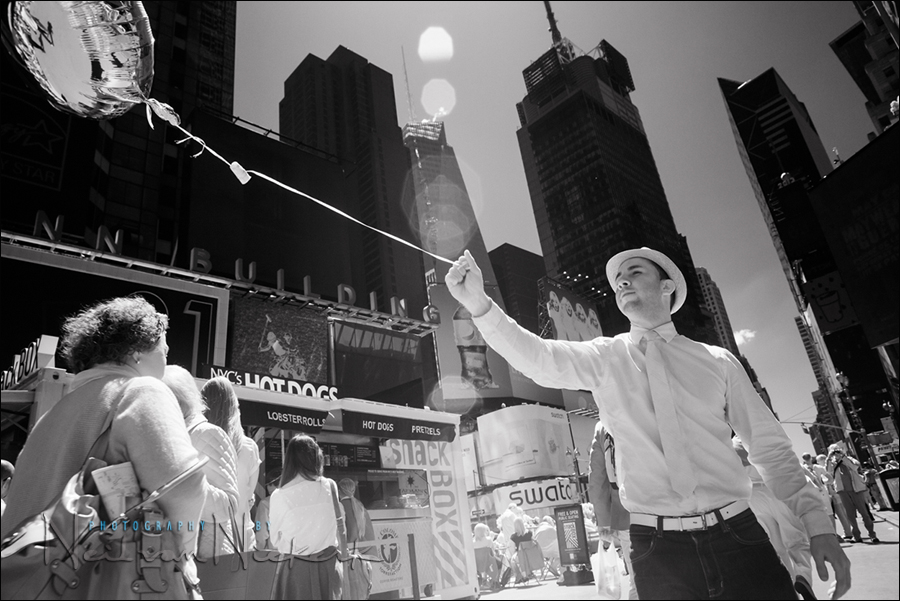
Digital B&W infrared photography
The ghostly beautiful infrared B&W landscapes have always drawn me. Something ethereal and other-wordly about them. So I’m not sure why it took me this long to pull the trigger on getting an infrared converted digital camera. But I end up buying a used Canon 5D mark II that had been converted to infrared. The conversion was been done by Life Pixel, adding a Deep B&W infrared (830nm) filter. They also adjusted the camera for ‘universal lens calibration’ to help with the focusing accuracy of the infrared light.
Today was the first time I took the camera out for a proper spin, but instead of seeking out landscapes, I ventured in to Manhattan, to see what it looks like … and I’m blown away. I love this. I love this effect more than I had anticipated.
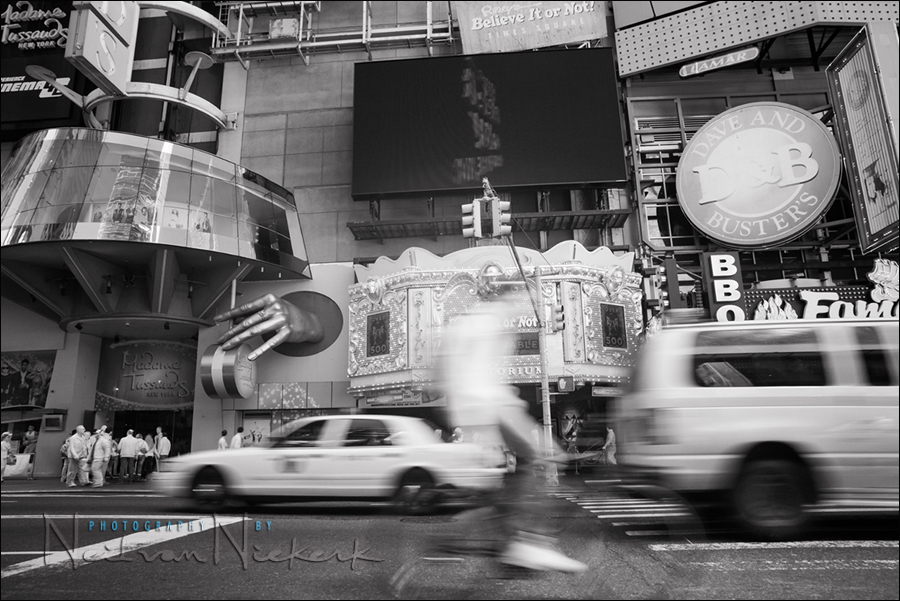
- Canon 5D mark II (830nm deep B&W IR conversion by Life Pixel)
- Canon 24-70mm f/2.8L II (B&H / Amazon)
- 1/25 @ f/8 @ 1600 ISO
Here I purposely kept to a slow shutter speed to blur the movement. That ghostly figure right in the front is a cyclist. One of the first things I discovered – the camera’s light-meter has no correlation to what is going to happen with exposure. In the end, the exposure was anywhere from 2 to 5 stops more than the meter would indicate. This is especially true for the shadow side of a building.
In the end, I found Live View mode to be the most helpful in getting to the right exposure. I kept the blinking highlights ON as well.
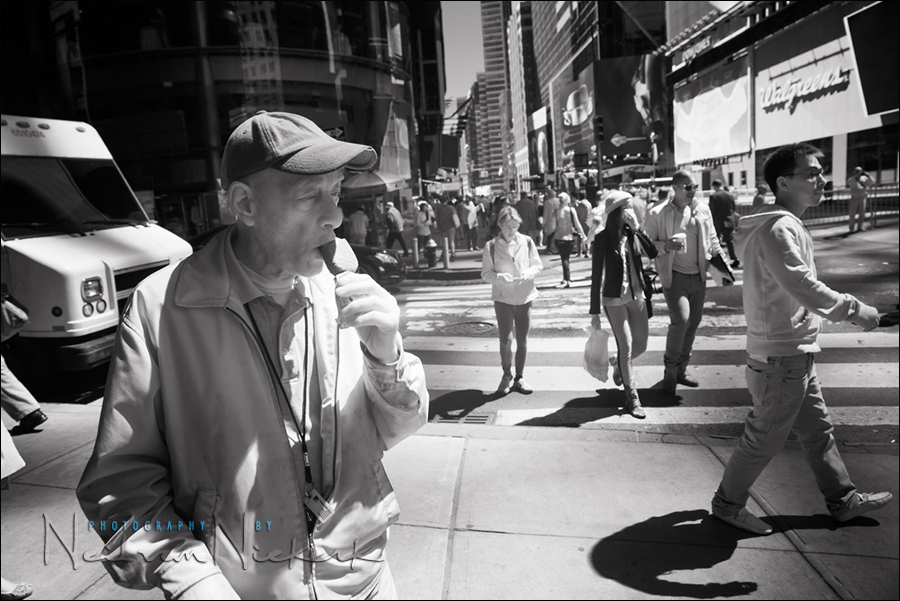
- Canon 5D mark II (830nm deep B&W IR conversion by Life Pixel)
- Canon 24-70mm f/2.8L II (B&H / Amazon)
- 1/250 @ f/5.6 @ 800 ISO
Street photography, as infrared, just has a slightly more surreal element to it, with random pools of light reflected from the glass buildings surrounding this scene.
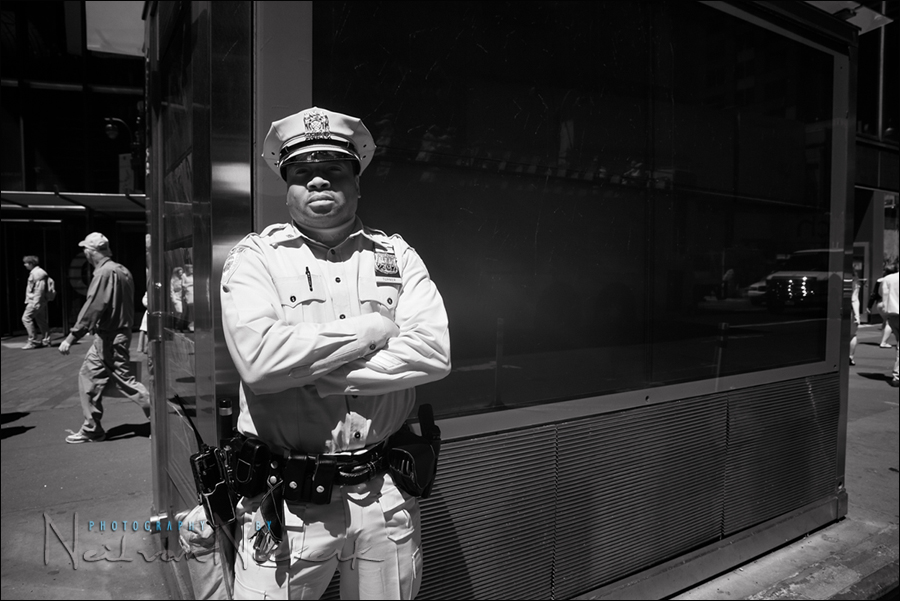
- Canon 5D mark II (830nm deep B&W IR conversion by Life Pixel)
- Canon 24-70mm f/2.8L II (B&H / Amazon)
- 1/200 @ f/6.3 @ 400 ISO
This policeman in Times Square very gracefully allowed me to take his photograph. And really, he was friendly and not as formidable as he looks. I was fascinated that his dark blue uniform would appear as this white tone, due to all the infrared light reflected.
Even as a newbie to infrared B&W, I’m already convinced that you can’t really emulate this look via Photoshop filters. Just taking changing the various tones around – eg, green tones to be very bright levels, and brightening red tones, and darkening blue tones – can’t effectively give you these kind of infrared surprises.
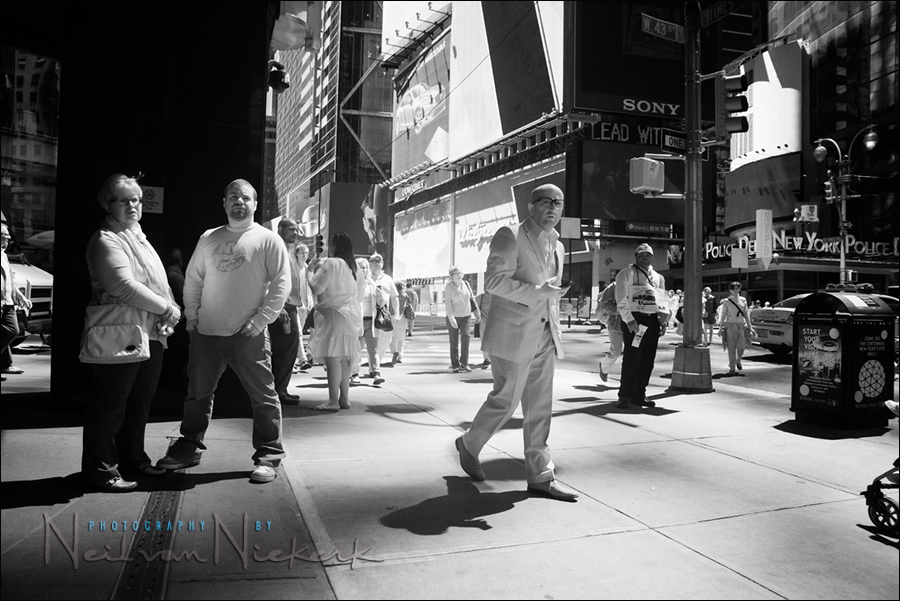
- Canon 5D mark II (830nm deep B&W IR conversion by Life Pixel)
- Canon 24-70mm f/2.8L II (B&H / Amazon)
- 1/400 @ f/5.6 @ 1600 ISO
What fascinated me here, is how the sun’s reflections from the various buildings, and the corresponding shadows areas, created these pools of light. This was one of the images I shot in Aperture Priority, with the EV set to +2. It’s pretty close when the light is bright.

- Canon 5D mark II (830nm deep B&W IR conversion by Life Pixel)
- Canon 24-70mm f/2.8L II (B&H / Amazon)
- 1/400 @ f/6.3 @ 800 ISO
Back to this image that was shown at the top – the guy with the balloon is Israel, and he was also very gracious and worked with me until we got the balloon just right in the frame. Thank you for helping!
I must say that I am pretty excited showing these few initial images – it feels like there’s a whole new strange world awaiting.
Converting your camera for infrared capture
If the look of infrared photography appeals to you, then you can have your camera converted by Life Pixel. On their website they list all the options, as well as which cameras are suitable, and which lenses might be a problem. There’s a ton of useful information on infrared photography! Check them out.
Related links
- B&W infrared photography – Urban landscapes
- New York cityscapes – B&W infrared photographs
- Mirrorless cameras and B&W infrared photography
- Gallery: Infra-Red B&W Photos of New York City
- B&W infrared landscapes – Opus 40
Neil,
I have a converted D100 and on that the meter was fairly usable. BUT you have to get the white balance right. Its a long time now since I did this. I think I did a custome white balance on some grass. It is way weird. Low temerature and skewed colours – as one might expect – but the meter became meaningfull.
There was an article from “digilloyd” which was very usefull.
cheers,
Great to see a different application for IR photography – these are fantastic! As you may have noticed, I immediately ran out to the nearest graveyard with my IR converted D70. Not cliched at all.
I’m currently using the flashing highlights feature to get the exposures close to alright – just keep cranking it up until I get my first few blinkies. But wild bracketing is still the order of the day – if my histogram looks good (exposed to the right etc), my images are massively underexposed. Depending on the quality / direction of light / mood of my dog.
Nice to see you’ve come over to the dark side Neil ;-) I shoot with a full spectrum camera, the best of all worlds and the ultimate vacation camera. When shooting straight full spectrum with no add on filters, you can get great B&W and get tonal range I never had before. Here’s an example
Hi
I have always wanted to try IR photography with film. I have tried with a little success within photoshop.
I’m wondering if an HDR programme could add a little to the effect. Has anybody tried?
Great images Neil.
Graham.
I love your use of infrared in an urban environment! I had my Canon 40D converted by http://www.DigitalSilverImaging.com about a year ago, much less expensive than http://www.LifePixel.com, but I have only shot landscapes. Thanks for the inspiration, BRILLIANT!